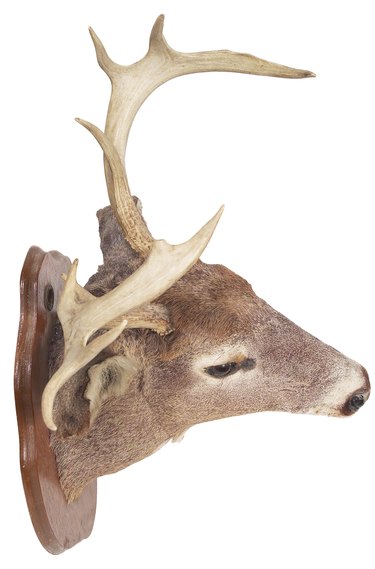
With life size deer mounts, antlers, the head and neck, the head and shoulders, or the entire body are usually preserved. The size of the deer determines the size of the mount. In the United States, mule or whitetail deer mounts are common. The size of the buck and the antlers depend on the deer's age, nutrition and genetics.
Deer Measurements
Video of the Day
A typical mule deer buck has a body length of 49 to 66 inches and a shoulder height of 33 to 42 inches. The neck circumference of a mule deer buck ranges from 12 to 25 inches. The width of the head measures 4 to 6 inches and the length ranges from 11 to 14 inches. Whitetail deer may be slightly smaller at maturity. Does are smaller than bucks.
Video of the Day
Measuring for Mounts
The base or inside of a deer mount is the form. The hide is stretched over the form to make the mount. For a full body life size form, the length of the head, the neck circumference, the distance from the tip of the nose to the base of the tail and the belly girth are measured. For a neck or shoulder mount, the distance from the front center of the nose to the corner of the eye is determined. Also, the neck circumference where the neck attaches to the head is measured. Then the circumference of the neck 3 inches down from the neck circumference measurement is determined.
Antlers
Bucks shed their antlers each year, usually between December and March. The antlers grow back during the late spring through early fall. While they are growing, the antlers are covered in a skin called velvet. When the antler reaches full size, the velvet is lost. Mounts are often made with full size antlers.
Record Size Antlers
Mounts are often prepared when the deer have unusually large antlers. A formula using a number of measurements creates a score for the size of the antlers. The tip-to-tip spread of the antlers, the greatest spread, the number and length of the points on each side, and the circumference of the main beams are some of the measurements used to determine record size antlers.
Recording Record Antlers
The Boone and Crockett Club, a nonprofit conservation organization founded by Theodore Roosevelt, records world record-size antlers mounts. Often the trophy-holding deer are 4 1/2 to 6 1/2 years old with at least 10 points. Deer antlers are considered typical or nontypical. Typical antlers are symmetrical while nontypical are not.
Typical Size Antlers
A mature mule deer's antlers average 20 to 22 inches from tip-to-tip while whitetail bucks average 15 inches. A two-year old buck has antlers that are about 60 percent of the antler size at maturity. The bucks are physiologically mature at about 4 1/2 years of age but the antler size is usually largest when the bucks reach 5 1/2 to 6 1/2 years of age.
- University of Michigan Museum of Zoology; Odocoileus virginianus; Mule Deer
- Oklahoma Cooperative Extension Service: Ecology and Management of Deer in Oklahoma
- Nevada Wildlife Record Book: Field Judging Trophy Mule Deer
- University of Michigan Museum of Zoology; Odocoileus hemionus; White-Tailed Deer
- Mississippi State University Extension Service: A Hunter’s Guide to Aging and Judging Live White-Tailed Deer in the Southeast
- Vermilion: Taxidermy